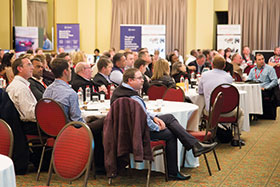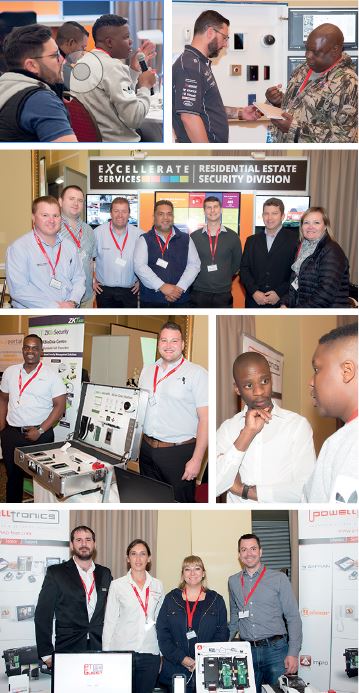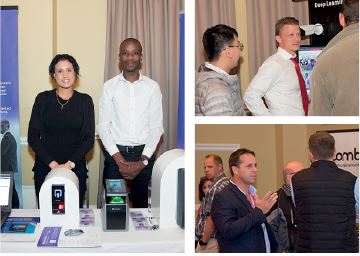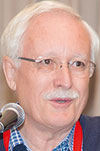

Residential estates are wonderful places to live, offering luxury, space, relaxation (often including sports facilities) and security. And it’s in the security aspect that problems often arise.
It’s a cliché, but when estates are designing their houses and facilities for residents, only the best will do; when it comes to security, the best is often set aside in favour of a cheaper option. As long as there are no determined attempts at breaching the estate’s security, cheaper options will often do the job for a while. Eventually, however, buying cheap will come back to haunt the estate, and be blamed on the estate or security manager.

Hi-Tech Security Solutions and Rob Anderson hosted the latest in our series of Residential Estate Security conferences in Johannesburg in August 2018 with the aim of assisting estate and security managers in making the right decisions when it comes to security.
The day saw a full house of people from estates, both in the security and operational fields, as well as a record number of sponsors which all had displays with various products and solutions aimed at the estate market. The sponsors on the day were:
• Bosch.
• Cathexis.
• Comb Communications.
• ELF Electronic Security Solutions.
• Elvey.
• Excellerate Services.
• GLOVent Solutions.
• Hikvision.
• IDEMIA.
• Powell Tronics.
• Tyco.
• ZKTeco.

Starting on the right footing

Rob Anderson from Adamastor Consulting started proceedings with a presentation highlighting the basics on how we should be making security decisions on estates. He provided attendees with a few lessons to take home that would help in ensuring their security decisions were beneficial and didn’t break any older systems already installed.
Starting out, Anderson said estates must first understand what they are trying to achieve, they need a set of standards for all technology as well as for the installation and maintenance thereof, which will be done according to a formal design process – which includes proper documentation, in advance. Then the system must be continually evaluated while in operation to ensure it delivers as promised – what Anderson calls Manage by Measurement.
When it comes to buying new technology, he says it must fit in with your existing systems. Don’t replace the whole system just to get the benefits of a single new product. In addition, make sure you train your controllers on the new technology to allow them to make full use of it. He added that an upgrade is only worth it if the operational team is better off than before the upgrade.
Anderson set the scene for the day and was followed by a range of presenters building on the topics he introduced.
The optimal handling of crime scene video footage

Estates all too often think they have video footage of an event, only to find it’s useless and doesn’t even make it to court. To avoid this scenario, Warrant Officer Bongiwe Gqotso offered some of the key points to consider when it comes to your surveillance installation.
Starting her presentation, Gqotso explained that often the police service is able to obtain video evidence of a crime, but is unable to use in in court due to two primary reasons: the placement of the cameras and the handling of evidence. Without the proper attention to placement you may find you have terabytes of video footage that won’t even get into a courtroom, let alone assist in a conviction.
Gqotso says the placement of cameras requires careful consideration. She suggests asking the following questions before deciding on where to install your cameras, as well as what cameras you intend to purchase:
• Why do you want CCTV?
• What do you want to achieve from the system?
• Will the end product (the captured video) assist the investigating officers?
As far as management goes, Gqotso says there are three important issues to consider. Firstly, maintain the camera system, she has had the experience of dead bugs obscuring the view. Secondly, make sure the date and time on all your cameras are accurate and synchronised. Finally, and this shouldn’t be a surprise, make sure that your system is recording. Finding out that the system is displaying footage on screen but not recording it after an incident is not as uncommon as one may think.
She ended her presentation by advising estates how they should collect their video evidence in a manner that won’t get it thrown out of court. A more detailed overview of her presentation was included in the Residential Estate Security Handbook 2018 and is available at www.securitysa.com/8453r
Ensuring optimal service

How many estates feel as if they are in a constant battle with their service providers to obtain the service and the performance they expect from their expensive security installations? John Cowley from C3 Shared Services was up next with a presentation on the best practices involved in ensuring you get the best service from your providers, from the first quote until the systems are decommissioned (and optimally, way past that point as well).
Cowley explained that when estates run their security and operations “by the seat of their pants”, it simply can’t end well. He said these organisations need to select a standard by which they operate and demand that their service providers adhere to the standard. The result will be an efficient organisation that delivers benefits to everyone, except the criminals who will find it harder to find weaknesses to exploit.
Giving a brief overview of the service provision process, Cowley explained that it starts with a baseline of the estate’s present state of security and ends with a desired state. With consultation and careful planning, a good service provider will be able to construct a roadmap from the present to the final state, taking account of the customer’s budget and other constraints. He suggests using the ITIL service management methodology, which was designed for IT, but the principles of a full service roadmap still apply. (“ITIL is a set of detailed practices for IT service management that focuses on aligning IT services with the needs of business.” – Wikipedia.)
Cowley also described the various service providers one can partner with, from the functional ones who focus on price and deliver as little service as they can get away with, to strategic partners and the top of the pile, providers who engage in a business process service with guaranteed outcomes.
Serengeti: a case study

Hannes Hendriks was up next to give the attendees some insight into the challenges and solutions he faced in more than a decade as estate manager at Serengeti Estate. The estate covers some 820 hectares with a 17.5 km perimeter, making securing it no easy task. Hendriks is a proponent of a layered approach to security. He says there is no single technology that could meet all your needs without being overcome by experienced people, hence the need for a layered, multiple-technology solution where risks are high.
Exactly what makes up these layers depends on the customer and their expectations, as well as a good understanding of the risks they face. However, it is important that estates take a holistic approach to site security. This means “the elements of a layered security solution are complementary and work in unison to provide a strong security regime which protects against both known and perceived threats.”
When it comes to security, Hendriks believes there are four pillars one must address for a secure estate. He adds that it is important to note that all these pillars must be based on the foundation of a single integrated management information system. The pillars are: the perimeter, access and egress control, the control room and the estate’s security force.
He also adds that the management system is critical. It is not something that can be bought off the shelf. It is a complex system that needs to be able to handle every issue the estate throws at it, preferably from the same interface. This means it needs to be easy to integrate security and non-security functions. A more detailed overview of his presentation is available at www.securitysa.com/8436r.
Is radar on your horizon?

Kelly McLintock from Blacklight Integrated was next on stage where he introduced the audience to a relatively new form of perimeter and area security, based on radar. The systems introduced can cover almost any area, up to a 15 km radius, using digital multi-beamforming S-Band radar technology designed specifically for ground and low-altitude surveillance. He says this offers reliability and accuracy, with the fewest nuisance alarms in any weather conditions.
The system comes with a web-based dashboard that provides an overview of the area being monitored (and it can be integrated into existing management platforms). Operators are not only provided with an overview, but can use the intelligence in the system to demarcate certain areas as restricted or open, and set rules as to what the system should do when a person or people are detected in these areas.
The system is also able to differentiate between people and animals, vehicles and so forth. This means you can set the system to ignore animals (including birds flying within the elevation the system is capable of) and raise an alert when people are spotted in specific areas. It also covers the whole area simultaneously, meaning that if intruders purposely set off an alarm in one or more areas with the intention of distracting the security team while their partners break in somewhere else, operators can see the distraction and ignore it while taking action to stop the real intruders.
And, of course, the radar operates in real time, allowing operators to track the intruders as they move about, keeping the responders informed. Most importantly, it integrates with existing security systems, such as surveillance cameras, which can automatically focus on the area and track the intruders, or lights can be switched on and two-way communications can also be triggered.
Surge and lightning protection

For security managers who have had their fill of lightning damage to cameras and other equipment, Don Drennan from Drensky Technologies was on hand to provide some insight into the dangers and solutions to lightning risk. Drennan started his presentation with the unfortunate news that lightning activity across South Africa has increased considerably over the past few years, even in coastal areas where there was little activity in 2011. He then showed the audience the different type of strikes that can occur and which pose a danger to electronic equipment.
Of course, surges from unreliable power supplies and other causes are also a danger to electronic equipment. He explained that electrical components fail 65% of the time is due to overstress, in other words, they try to handle more current than they were designed to, which ‘fires the components’. Drennan showed a few examples of what can happen when a bolt of lightning or even a surge over-stresses various components, with predictable results.
Drennan stressed the importance of installing systems according to standards, such as SANS IEC 62305, among others, but added that correct earthing is a vital component of lightning and surge protection. He explained that an effective earthing system diverts excess energy away from protected equipment, but poor earthing results in a reduction of protection. It is also critical to properly maintain your earthing systems according to the manufacturer’s specifications to ensure optimal operation.
He then delved further into surge protection, looking at various low, medium and high energy devices before ending his presentation with a live demonstration of what happens when electrical components are faced with too much electricity.
Merging two luxury estates

As if managing the security for one large luxury estate is not hard enough, Danie Bosman was up next to discuss the issues and challenges faced when merging two luxury estates. Bosman is the security technical manager at Val De Vie Estate.
Val De Vie is rich in history and forms part of a larger World Heritage Site. Security is a top priority throughout the estate, which consists of a 13.9-kilometre perimeter, protected by a 2-metre high wrought-iron fence with under-dig razor wire, concrete plinths and full electric fence, all covered by 97 intelligent analytical Bosch thermal cameras. The estate has four main access points providing entry via 27 vehicle access and exit lanes and 14 turnstiles for residents, employees and contract workers. Strict access control measures are in place at these points and each point is monitored with an array of cameras.
In 2016, Val De Vie and Pearl Valley Golf Estate merged the massive task of amalgamating the two estates into one began. This included amalgamating the security systems to ensure the safety of the residents and visitors. There were a number of challenges, but getting the access control system right was the highest priority.
The decision was made to standardise access across the combined estate using Impro’s IXP 400i (which was subsequently upgraded to Impro’s Access Portal solution), Softcon HID keypads, Sagem OMA 520D readers among other equipment. It was also decided to make use of Powell Tronics’ PT-Guest system to manage visitor entry and exit.
The biggest challenge was merging the databases and Bosman said the technical support from Powell Tronics played a significant role in dealing with the problems the estate faced in this regard.
The future of integrated technology

Jaco Liebetrau from Bosch Building Technologies kicked off the last two presentations which were focused on technology pertinent to residential estates. Liebetrau focused on the benefits estates (or any organisation) could obtain through the effective integration of various security systems.
Touching on the evolution of the security industry, he showed how smarter software is enabling solutions that were considered impossible in the past. The implementation of this technology will see security systems moving past simple integrated alarm systems to smart situation management and then through to pre-emptive situation management where security teams will be able to proactively prevent incidents before they happen based on information they receive from their technology.
Key to this is the Internet of Things (IoT), which will see over 28 billion connected electronic components in 2020. This will be used for a host of functions, from parking management through to farming, and of course, improved security. Already intelligent analytics are able to do more, faster than ever before – and with improved accuracy.
Liebetrau also touched on some advanced technologies, such as Bosch’s resilient video management solutions that are designed to keep working even if one or two components of the system fail. Added to this are intelligent compression techniques which reduce the bandwidth and storage required for high-definition video.
He ended his presentation with some insights into thermal cameras from Bosch, as well as a glimpse at what smart homes of the future will look like.
Technology for residential estates

Shaun Savage from Hikvision SA ended the day with another presentation focused on the latest technology estates can make use of. His presentation touched briefly on various solutions which cater not only for the normal security issues estates face, but are able to go the extra step in simplifying and improving the security posture of an estate.
Savage started with the perimeter, highlighting how the latest technology from Hikvision offers perimeter protection boosted by intelligent software that detects motion on the perimeter, but goes further in that it can automatically identify who or what is moving, avoiding false alarms when animals or vehicles are detected. In fact, the technology is able to identify humans even if they crouch or crawl, and the system can learn to ignore branches blowing in the wind and other non-security events.
He then looked at thermal cameras and the analytical software that makes these cameras even more efficient on the perimeter, only raising an alarm when people are in a restricted area or cross a line, again ignoring events caused by animals or birds.
Entrance and exit verification systems were next on his list. He showed how biometrics can be used with other functionality (like licence plate recognition) to create a dual verification system. Finally, he ended with a look at facial recognition and the various applications of this technology in the real world to enhance access control systems. Facial recognition has had a bad reputation when it comes to real-time operation, but Savage says the latest software dramatically improves the reliability of this technology, to the point where it can be used in various different scenarios.
The Residential Estate Security conference proved to be popular with attendees and Hi-Tech Security Solutions would like to express our thanks to everyone who attended. In addition, our thanks goes to Rob Anderson for his assistance in putting the conference together. Finally, we appreciate the support from our sponsors who were kept busy at their stands throughout the day. If you have any topics pertinent to the residential estate market that you feel should be covered in future conferences, please let us know by sending an email to [email protected]
| Tel: | +27 11 543 5800 |
| Email: | [email protected] |
| www: | www.technews.co.za |
| Articles: | More information and articles about Technews Publishing |
© Technews Publishing (Pty) Ltd. | All Rights Reserved.